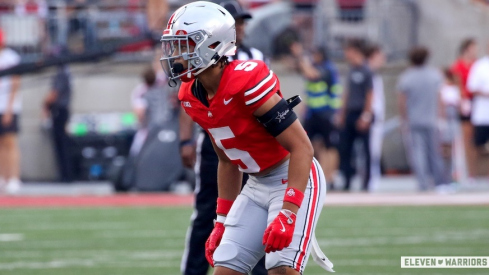College football's biggest news over the weekend arguably came from a team that didn't play.
Ohio State quarterback J.T. Barrett was cited for an OVI early Saturday morning near a checkpoint around the campus area. Barrett, 20, was charged with a total of three misdemeanor offenses, including the OVI charge. Additionally, he was charged with an OVI per se — which stems from Barrett blowing a .099 during an administered breathalyzer test — and "backing without safety" which is defined as "prohibiting the willful fleeing or eluding of a law enforcement officer" in violation of section 2921.331 of the Ohio Revised Code.
As a result, the redshirt sophomore quarterback was suspended for Saturday’s game against Minnesota by head coach Urban Meyer. In his weekly press conference Monday, Meyer noted Barrett will go through some university-enforced penalties for this incident.
“He has to do counseling and some other things through the university,” Meyer said. “That will be done.”
There are legal ramifications that stem from Barrett’s OVI, as well. He is scheduled to appear in court 9 a.m. Friday, according to Franklin County Courts records.
Two Columbus-area defense attorneys spoke to Eleven Warriors about what can generally be expected, from a legal standpoint, for a first-time offender like Barrett. Both Eric Brehm — managing attorney and founder of Brehm & Associates — and Jessica D’Varga — an associate attorney specializing in OVI, criminal and traffic offenses at Saia & Piatt — said after a brief review of the court records that Barrett’s case seems to be a somewhat standard OVI case.
"This is a very typical situation that people can find themselves in,” Brehm said. “This is a very pedestrian, very common type of case.”
In the state of Ohio, an OVI is considered a first-degree misdemeanor which means it "can be punishable by up to six months in jail and up to a $1,000 fine," Brehmn said. Those are the maximum punishments.
The minimums for a first offense is a choice by the court for three days in jail or three days in a driver’s intervention program, depending on the circumstances of each individual case. Because there is no report of an altercation, nobody was harmed or anything of that nature, both Brehm and D’Varga said the latter — three days in a driver’s intervention program — is the likely option in Barrett's case.
“Generally speaking on first offense OVIs, especially in Franklin County, because it’s a [misdemeanor 1], generally what they do is a three-day driver’s intervention program,” D’Varga said. “It’s basically 72 hours of drug and alcohol counseling that they usually conduct at a hotel, but it’s run by a drug and alcohol counseling program. You have to check in and then you can’t leave until the 72 hours are up, but it’s certainly not jail.
“That’s a pretty standard punishment in a case like this.”
Barrett will also likely face a suspension of his driver’s license and pay a fine. The minimum fine is $375, D’Varga said, and the suspension of Barrett’s license is likely to be six months should the charges stand as they are.
Both attorneys did say, however, a reduction in charges is a possibility in this specific instance. D'Varga said it's a possibility Barrett's case could be reduced from an OVI to an OVIUAC, which is operating a vehicle while impaired with underage consumption. That charge is a misdemeanor 4, D'Varga said, as opposed to the misdemeanor 1 a standard OVI carries.
“This is a very common charge and this is something that really can happen to anybody on any given night,” Brehm said. “The penalty that he is going to face is probably very clearly going to fall within the minimums or he’s going to get a reduction down to a different charge.”


